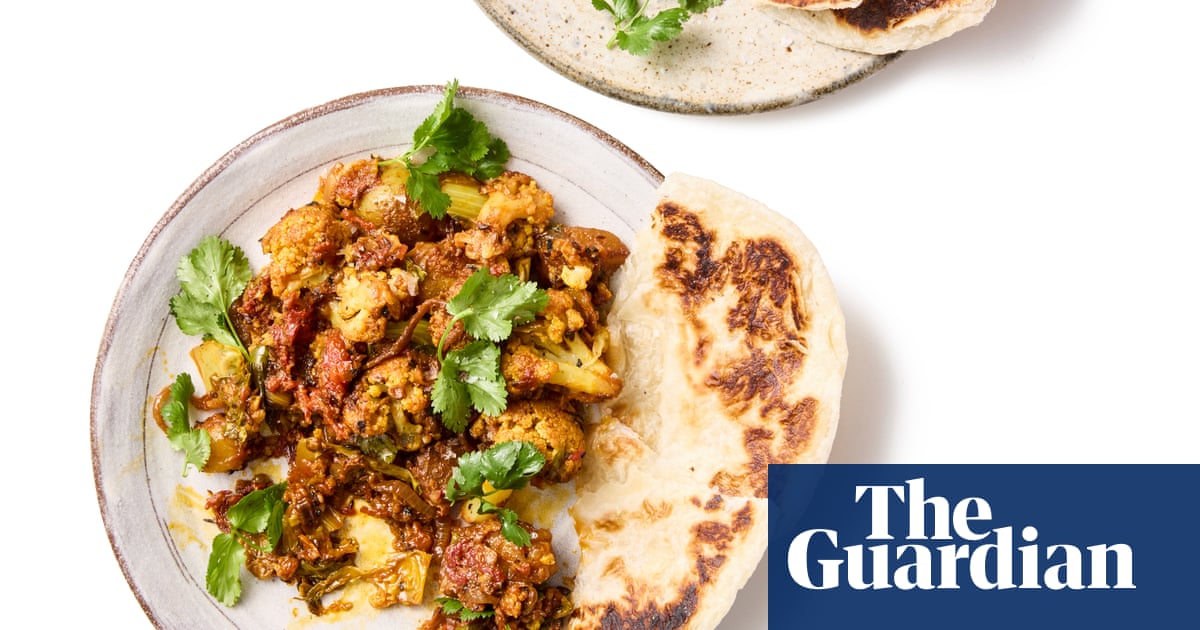Described by chef Vivek Singh as “the most common and basic vegetable curry you will find anywhere in India”,aloo gobi(the name means potato cauliflower in Hindi) makes a great vegetable side dish, but it’s also full-flavoured enough to pair with plain rice or flatbreads for a very satisfying (and incidentally vegan) main meal.
Prep20 minCook1 hrServes4
350g waxy potatoes1 red or yellow onion1 medium cauliflower20g fresh root ginger, or 1 tbsp grated ginger4 garlic cloves400g tin plum tomatoes, or 5 fresh plum or medium tomatoes and 1 tbsp tomato puree2 tsp coriander seeds4 tbsp neutral oil1 tsp cumin seeds½ tsp nigella seeds½-1 tsp mild chilli powder½ tsp turmeric1-4 green finger chillies1 tsp salt1 tbsp methi(dried fenugreek leaves)1 tsp garam masalaJuice of ½lime1 small bunch fresh coriander
Chop the potatoes (common waxy varieties, often sold as salad potatoes in the UK, include charlotte, nicola, anya and jersey royals) into roughly 2½cm dice; there’s no need to peel them, but if they’re a bit dirty, give them a good scrub first.
Peel and finely slice the onion (I like the sweetness of red in this dish, but brown will work fine, too).
Cut any leaves off the cauliflower, saving those that are in good shape to add to the dish later (or use them in a soup or stir-fry, if you prefer).
Trim off and discard the base of the stalk, divide the top into bite-sized florets and cut the remaining stalk into chunks about the same size as the potatoes.
Peel the ginger (a teaspoon is the easiest tool for this) then finely grate or chop it – you should end up with about a tablespoon.
Peel and grate or crush the garlic (I usually put both in a mortar with a pinch of salt and mash them to a paste). Roughly chop the tomatoes; if using tinned, save the juice.
Put a wide pan for which you have a lidon a medium-high heat, toast the coriander seeds until aromatic, then tip out on to a small plate.
Pour in half the oil, fry the cumin and nigella seeds for a few seconds and, when they start to pop, add the potatoes and saute until lightly golden (they don’t need to be cooked through just yet).
Using a slotted spoon, scoop the potatoes into a large bowl, leaving as much oil as possible behind in the pan, then saute the cauliflower, frying just to colour it slightly.
Scoop into the potato bowl (if you’re using the leaves, shred them, saute them separately until wilted, then put in a different bowl from the florets and stalk).
Turn down the heat a little, add the remaining oil and fry the onion until softened but not browned. While the onion is cooking, grind the coriander seeds. Add the garlic and ginger paste to the hot pan, fry, stirring, for a couple of minutes, then stir in the ground coriander, chilli and turmeric, and cook for 30 seconds or so.
Tip in the tomatoes (and tomato puree, if using) and cook, stirring occasionally, until the oil starts to separate out from the sauce and bead around the edges of the pan, and the sauce thickens slightly. Meanwhile, slit the fresh chillies down their length (finger chillies can be quite hot, so adjust the number according to your liking for heat).
Return the potatoes and cauliflower to the pan, add the fresh chillies and salt, stir to coat everything with the sauce, then bring to a simmer. Turn down the heat, cover and cook for 25 to 30 minutes, until both the spuds and cauliflower are tender. Stir occasionally, to make sure it doesn’t catch, and add a splash of water if it threatens to do so.
Take the pan off the heat, stir in the methi and garam masala, plus the sauteed cauliflower leaves, if you have any, and leave the rest, still covered, for 10 minutes. Stir in the lime juice and check the seasoning, adjusting as necessary, then decant into a large bowl. Chop the coriander, scatter over the top and serve with rice or flatbreads.
